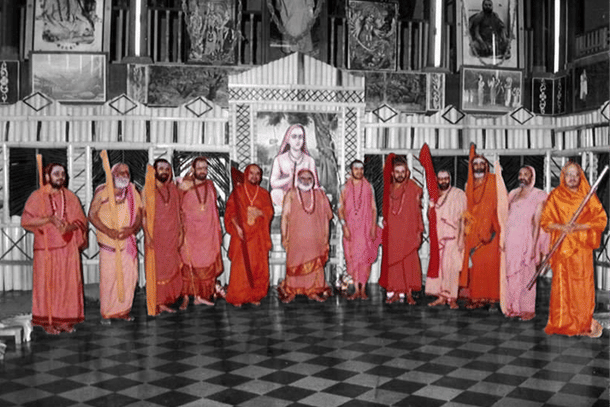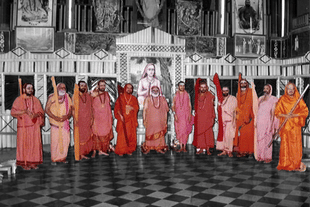Commentary
Shankaracharyas, Hindu Unity, And The Ayodhya Triumph Of Ram Bhaktas: A Closer Look
Aravindan Neelakandan
Jan 18, 2024, 08:51 PM | Updated Jan 20, 2024, 11:29 AM IST
Save & read from anywhere!
Bookmark stories for easy access on any device or the Swarajya app.


The recent disputes surrounding the Shankaracharyas and their purported neglect of the Prana Prathishtha ceremony at the Shri Ram temple in Ayodhya have introduced an uncomfortable element into an otherwise joyous homecoming of Shri Ram to Ayodhya.
Most of the news, however, around them is either distorted, exaggerated, sensationalised or utterly false.
In fact, two Shankaracharyas from southern India—of Sringeri and Kanchi—have already sent their blessings for the 22 January event. They have repeatedly rejected the news that Shankaracharyas are against the consecration.
So, the statement that all Shankaracharyas are against the Prana Prathishtha ceremony or that they are unhappy about it, is obviously wrong.
The Shankaracharyas In Hindu Society
Hindu Dharma is a unique, expansive and dynamic phenomenon that has evolved over the ages. In the last two hundred years, Hindu society has, in various ways, begun to perceive the Shankaracharyas as a form of papal authority. This is kind of a self-imposed restriction which constrained the community at various points.
At the same time, Hindu society has definitely progressed, adeptly breaking free from these limitations and, at the same time, incorporating and transcending them.
From the abolition of child marriage, to entry of all Hindus into the temples irrespective of castes, Hindu social leadership had consistently sought the support of the Shankaracharyas. Unfortunately, history shows us that the Shankaracharyas, and most of the traditional Acharyas, were against the progressive measures Hindu society took.
Had Hindu society obeyed the dictates of the Dharmacharyas rather than listen to its own Dharmic wisdom, India today might have resembled a fundamentalist state, particularly with regards to women's education and social progress.
On the night of Shivaratri of 1888, Sri Narayana Guru did Prana Prathishtha of a Shiva Linga. That temple is today a centre of the essence of Vedantic wisdom.
However, when Bhagwan Sri Ramana Maharishi sought to install the Matru-Bhutheswara Shiva Lingam on his mother's samadhi, Shri Chandrasekarendra Saraswati, the Shankaracharya of Kanchi, objected to Linga-Prathishda saying that according to shastras there could be no renunciation for a woman.
Here, it is critical to remember that shastras have to follow the ever-manifesting, infinite glory of Dharma. Dharma cannot restrict itself to the time-bound perceptions of shastras.
The Shankaracharyas have also evolved over time.
Shri Chandrasekarendra Saraswati blessed a team of orthodox Brahmins going to Kerala to preach against temple entry of Scheduled Communities, when satyagrahas for temple entry were happening. However, Shri Jayendra Saraswati, his successor, issued certificates for the graduates of an institution that trained students from all castes to become archakas in the very same Kerala temples.
Still, they are one sect among many different Hindu sampradayas. They do not have a special authority over all Hindus. Even among those Hindus who may believe in, or walk the path of, the non-dualism of Adi Shankara, not all communities would accept them as authority.
For a Kerala Hindu, Sri Narayana Guru would be a higher authority on Advaita than a Shankaracharya.
For a Tamil Hindu, the Kovillur Math or Swami Chidbavananda may be a higher authority than a Kanchi Shankaracharya.
Even among Smarta Brahmins, not all may submit themselves to an authority of a particular Shankaracharya.
Hinduism lives and thrives in this pluralism.
So when even a responsible mainstream media outlet writes that ‘just like the Supreme Court of India is the final authority when it comes to interpreting the Constitution, the Shankaracharyas are the "supreme authority" in Hinduism and for interpreting Hindu scriptures’, it is empirically wrong, historically fallacious, and ethically dangerous.
They are not.
Indeed, the RSS has undertaken a formidable task, managing to achieve a degree of success despite internal tensions. It has seemingly accomplished the improbable feat of uniting Hindus from various sampradayas without compromising their distinct identities or subjugating one sampradaya to the perceived superiority of another.
Concurrently, the RSS has aimed to establish a foundation of social justice for all sampradaya-followers as Hindus. While the organisation hasn't attained complete success and faces notable internal challenges, its accomplishments are nothing short of extraordinary.
The Ayodhya movement stands as a remarkable success for our civilisation, impacting not just Hindus but indigenous religions globally.
This achievement was made possible by the active involvement of all Hindus. Those at the forefront of the movement were driven by an unwavering devotion to Shri Ram; considerations of Smritis, Shrutis, Vedanta, or Siddhanta did not occupy their minds.
They bravely faced bullets, traversed paths laden with stones and thorns, all for the singular goal of witnessing Shri Ram ascend the throne in Ayodhya.
This is Shri Ram coming back to his throne after an exile of 500 years. Let all sampradayas heed to the Dharma that vitalised the sacrifices of those Ram bhaktas. They wanted this to happen. Nay. Their sacrifices willed this to happen.
They know neither Shankaracharyas nor Ramanandis nor any other sect or rules. They knew only Shri Rama. Their souls, eternally abiding in Shri Rama, would be blessing this event which they could not see with their own physical eyes.
Narendra Modi at the Prana Prathishtha is the representative of those Ram bhaktas, who hailed from all castes, all regions, all sampradayas, and from all of India. And as that representative, Sanatana Dharma makes him the most eligible person to do the Prana Prathishtha.
Before Ram bhakti, every thing else is immaterial.





